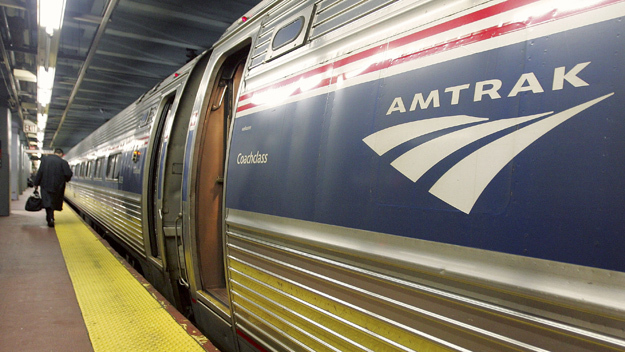Amtrak’s Penn Station in New York City, once one of the most glorious cathedrals of commerce built by one of the most successful transportation companies in history, is collapsing. Tracks are in disrepair. That’s because they have not been properly maintained over decades since Amtrak, despite promises to the contrary at its founding in the 1970s, has consistently lost tons of money. By its own admission, it hasn’t been able to adequately fund even routine maintenance.
Trains are jumping the tracks at Penn Station. Trains for the national passenger railroad—the disastrous, deficit ridden Amtrak with its pathetic so-called high-speed Acela trains, which are anything but high speed in many places— have been delayed as have the commuter railroads also using Penn Station, New Jersey Transit and the Long Island Railroad. The latter, in true government enterprise fashion, both lose tons of money. They seem to be run for the benefit of anyone but the long-suffering passengers and taxpayers who pay for this government engineered mess. This summer the number of trains that will enter and leave Penn Station will have to be reduced. That is making commuters and long-distance rail passengers groan.
Fewer tracks at Penn Station will be available because repairs, which should have been done years ago, must now be done on an emergency basis. The ripple effect from the government railroads’ woes have been felt through the Northeast of the United States. It affects the whole region’s economy in a number of ways, including the number of people who decide to drive and clog the government’s many poorly maintained roads and bridges (Is everything the government runs a mess? Probably. Recently, I had the misfortune of serving on a jury in New York State court in Jamaica, Queens. The courthouse, built in 1939, was not properly maintained and seemed like something out of 1839. Carfare was not given to jurors. And the poor judge, a good man who wanted to do the best by the jurors and run a fair trial, frequently had to adjourn the case early in the day because of “budget constraints”).
Don’t Know Much About History
What is to be done to save this Penn Station, which is not the original one built by the long-gone Pennsylvania Railroad in the early part of the 20th century. That’s when that railroad was one of the most profitable enterprises in the world and could afford to build the most beautiful stations.
How to fix a government mess? It’s an old story with a familiar answer. Make the taxpayers pay and pay.
So most New York/New Jersey pols, many of whom hope their constituents have no knowledge of the egregious history of government enterprise are falling all over themselves proposing the same solution that they and their predecessors have been proposing for close to half a century: Reward government incompetence. They are betting that voters and taxpayers forget. They are hoping they forget that Amtrak is just one in an endless list of government enterprises that failed but only survive thanks to endless taxpayer geld. They hope the taxpayers and citizens of the United States will forget the promises of Amtrak. Back in the early 1970s, when Amtrak took over from a group of private railroads driven into bankruptcy by overregulation, Amtrak officials promised that “now we’re going to see the greatest turnaround in business history.”
I’ve Seen the Future. And It Doesn’t Work
Yet with lots of government resources—although Amtrak supporters will say that this flawed line never gets enough from the taxpayers—the railroad has become a disaster. “Amtrak is a rolling Enron that should be allowed to go bankrupt,” said Ken Bird, a former Amtrak supporter as quoted in the book “End of the Line. The Failure of Amtrak Reform and the Future of America’s Passenger Trains.”
By the way, this excellent book by Joseph Vranich, the head of the High-Speed Rail Association, is a convincing indictment of Amtrak.
Why?
Because so many of the comments come from people like Vranich who once supported nationalized railroads and now readily confess that the experiment has been a failure for decades.
What’s to Be Done?
Most pols such as Senator Chuck Schumer say give more money to the government enterprise (sic) company that runs Penn Station, a perpetually money losing and accident prone national passenger train service. The logic of this idea is tantamount to saying that the drunk’s problem can be cured if we just give him one more drink (And in the case of Amtrak, it better be a big one and the taxpayers better be ready to pay for lots of refills).
This is the wrong answer. The right answer is to think creatively; it is in out of the box thinking. It is not to do what has been done with Amtrak for close to 50 years. It is to stop funding failure. It is to tell the Amtrak executives and their enablers in Congress and the presidency that enough is enough. It is to reach a logical conclusion. It is to say that the government should get out of the railroad business. It is to learn the lesson that government and business don’t mix.
It is to sell Amtrak (Which my wife and I recently rode to upstate New York earlier this year. For more please see https://gregorybresiger.com/good-buysbad-buys-bad-buy-egregious-government-enterprise/) and at the same time also the wretched collapsing New York City subways. It is to recognize the disastrous experiences of state governments trying to run railroads in the 19th century (Michigan ended up getting out of the railroad after a terrible experience in which politicians tried to design railroads and made a mess cleaned up by the taxpayers). It is to get the government out of the businesses of running all enterprises. Government has a role to play, but it is not in running businesses.
Gregory Bresiger is an independent business journalist who lives in Kew Gardens, Queens, New York.
![]()
